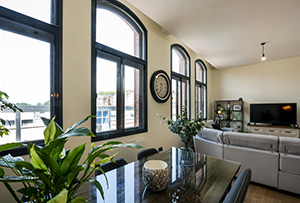Secondary Glazing for Heritage Windows
12 January 2024
Preserving Heritage: Unlocking the Potential of Secondary Glazing in Listed and Historic Buildings
 Listed and historic buildings stand as timeless testaments to architectural brilliance, each telling a unique story of the past. Yet, maintaining these structures often involves navigating a delicate balance between preservation and modernization, especially when it comes to the challenge of upgrading windows. In some cases planning and conservation consents and permissions can leave homeowner with limited options when looking to improve the thermal and acoustic performance and the security of existing windows.
Listed and historic buildings stand as timeless testaments to architectural brilliance, each telling a unique story of the past. Yet, maintaining these structures often involves navigating a delicate balance between preservation and modernization, especially when it comes to the challenge of upgrading windows. In some cases planning and conservation consents and permissions can leave homeowner with limited options when looking to improve the thermal and acoustic performance and the security of existing windows.Enter secondary glazing – a solution that not only respects the architectural heritage but also provides a host of benefits that are indispensable for the comfort and security of these cherished spaces.
The Challenge of Window Renewal in Historic Spaces
In the realm of listed and historic buildings, the charm lies not only in the grandeur of the architecture but also in the intricate details of original features. However, when faced with the need for window upgrades, strict constraints can often prevent outright replacements. This is where the versatility of secondary glazing comes into play, offering a solution that allows for internal installation without compromising the external aesthetics.
Preserving Externally, Enhancing Internally
Secondary glazing serves as a discreet yet powerful ally in the quest to enhance the performance of windows in historic buildings. By being installed internally, it allows preservationists to respect the external facade while unlocking a range of benefits that address common issues faced by older buildings. The narrow profiles of the secondary glazing means that they virtually invisible from the outside.
Improved Thermal Performance
One of the primary challenges with original windows in historic buildings is their inherent lack of thermal efficiency, with thin single glass panes and little to no draught proofing. Secondary glazing acts as a supplementary thermal barrier, reducing heat loss and enhancing insulation. This not only improves the comfort of occupants but also contributes to energy efficiency, aligning with modern sustainability standards without compromising the building’s historic integrity.
Enhanced Security
Security is a paramount concern for any property, and historic buildings are no exception. Secondary glazing provides an additional layer of defense, reinforcing the existing windows and making it more difficult for potential intruders to breach. This added security feature ensures that the valuable contents of the building are protected without altering the external appearance.
Superior Acoustic Performance
Nestled in urban environments, many historic buildings face the challenge of excessive external noise. Secondary glazing acts as a shield against these disturbances, offering improved acoustic performance. This means that occupants can enjoy the tranquility of their property without being disrupted by the hustle and bustle of the outside world.
Conclusion:
Is secondary glazing for you? Well, if you are in a position where either conservation restrictions or budget constraints are preventing you from upgrading your existing windows then secondary glazing could be the best solution. At H&C Joinery we supply what we believe to be the UK’s best secondary glazing system, that allows homeowners to improve thermal performance, acoustic reduction and increased security.
We offer an installation service for secondary glazing in Newcastle Upon Tyne, Durham, Northumberland and North Yorkshire, and a supply only basis nationwide if you would like to learn more about secondary glazing then please feel free to contact us.
Other Press Releases By This Company
- 15/02/2024 - Frequently Asked Questions
- 12/01/2024 - Timber Joinery and Thermal Efficiency: Keeping Your Home Cozy




